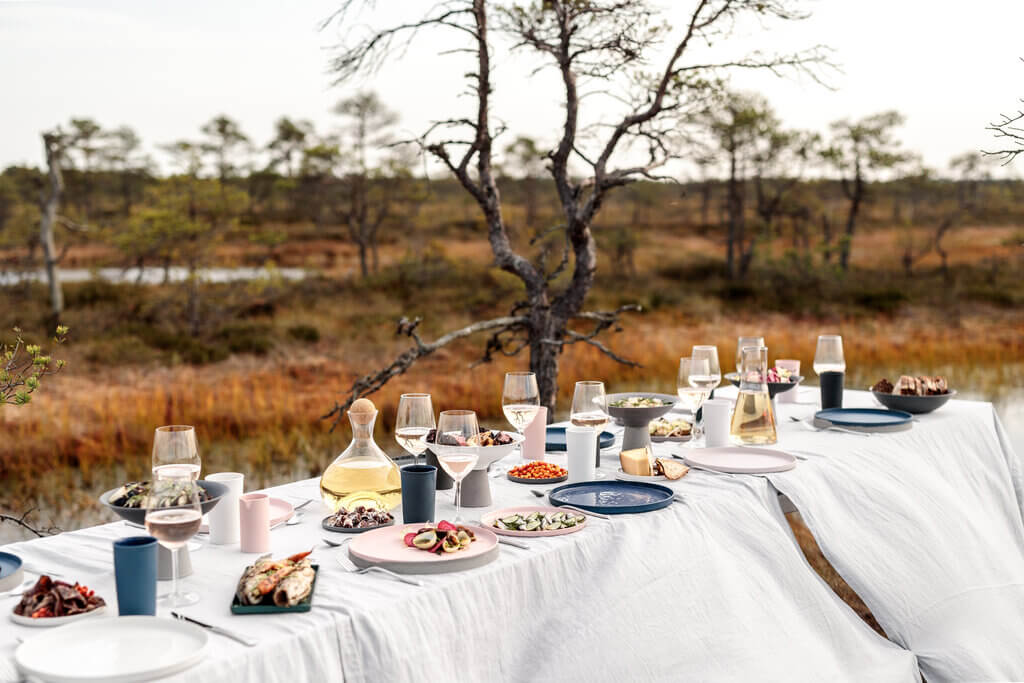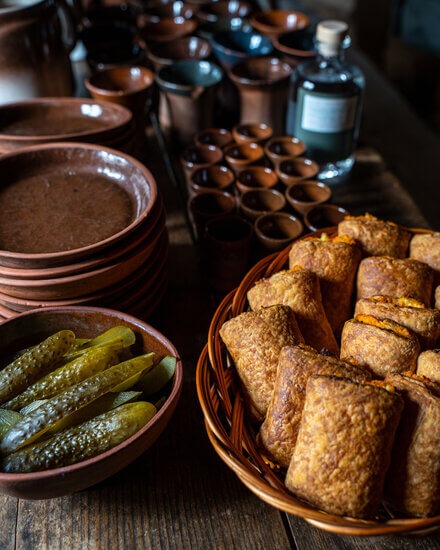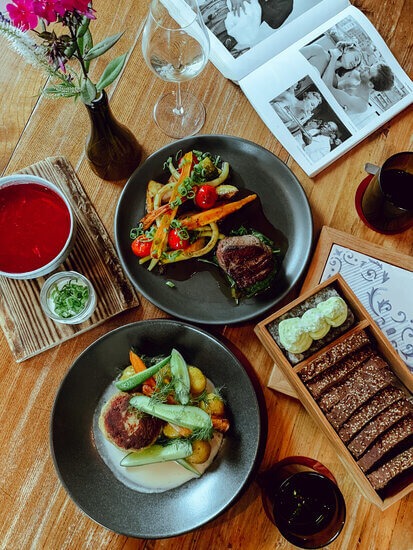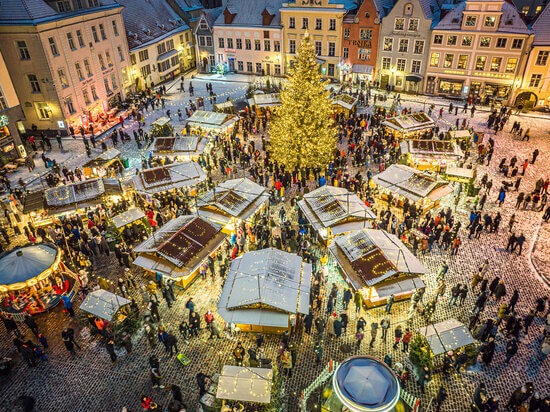10 tantalising tidbits to know about estonian food
What makes Estonia so special? Find out in our new series - learn some fun and lesser-known facts about the food, culture and history of the digital nation!

You might be wondering… What do Estonians eat? Or what is the national dish of Estonia? In this article, I'll give you a sneak peek into Estonian cuisine and share how we love celebrating food in our culture. Take it from me - our cuisine is slightly more interesting than just potatoes and pork!
Last time in our Estonian culture series, we explored some fascinating facts about the Estonian language and how we earned our reputation as the digital nation. While we surround ourselves with innovation and take pride in turning ideas into unicorns, we must not forget the essential fuel behind our ideas and joyful spirit—food!
Discover ten tidbits to tantalise your taste buds and learn all you need to know about Estonian food, where flavours shift with the changing seasons and time-honoured food traditions are passed down through generations.
1. Four seasons of different cuisines.
Estonians have a deep love for nature, which means we enjoy harvesting our food. It's common to have a small garden for growing vegetables, indicating a high value of local ingredients. As autumn approaches, you'll find many dishes featuring freshly foraged mushrooms or desserts made with just-picked berries.
During the colder season, winter is the time to open the preserved foods to bring back the flavours of summer, filling the kitchen with the warmth of homemade jams, pickles, and sauces that were carefully stored away during the late summer and autumn harvest.
2. We love pickling our food.
Estonians have been preserving food for generations during the summer and autumn, from cucumbers to fish, to prepare for the winter.

As mentioned above, Estonian cuisine changes along with the seasons. During the summer months, we savour fresh, seasonal goods and begin preparations for the winter ahead.
For generations, Estonians have mastered the art of food preservation. It might come as a surprise, but we love pickling and canning almost anything edible – from meat and fish to vegetables. Worth mentioning are essential summer snacks and recipes passed down through the ages- salt pickles.
You might wonder what’s so special about salt pickles, but I promise you, Estonians could argue with great passion over the best way to pickle cucumbers! From the choice of spices, like dill and garlic, to the debate over the perfect balance of salt and water, everyone and their grandmother has their own ‘correct’ method.
3. A staple at every Estonian dinner table - black bread
It’s well known that Estonians “have a love affair with their bread - as a dietary staple and a symbol of cultural identity”.

You might ask: what’s the hype about this dark rye bread called must leib (black bread)? And why is it found in almost every bakery or restaurant in Estonia?
I can promise you, this fluffy bread with a crispy crust is a staple of our dining routine. Whether it be breakfast or dinner, there are multiple variations on how to enjoy the bread. The main ingredient goes way back in time. Rye was a central part of the nation's traditional agriculture and shortly became a major export across Europe during the Middle Ages.
If you are ever invited over for dinner by your Estonian friend, I can almost guarantee they will welcome you with freshly baked black bread, straight from the oven. Pair it with some rich Estonian butter, and it's sure to be a delight for your taste buds.
And if you are ever invited to an Estonian housewarming, make sure to take some black bread and salt - it’s tradition - and will surely put you in the good graces of your hosts!
4. Fish and meat serve as central elements in Estonian cuisine.
For generations, Estonians have believed that meat provides the strength to survive the cold winters and the energy needed for a hardworking lifestyle. Growing animals has been an integral part of rural life, and for generations, meat has remained a key element in Estonian meals. The most common dish for instance is roasted meat with vegetables and usually fresh salad on the side. Many restaurants and coffee shops offer a päevapraad (daily special), which typically includes a portion of meat, vegetables, salad, and a choice of buckwheat, rice, or potatoes. Restaurants increasingly offer veggie options too!
5. The flavours of Estonian food can vary depending on the different parts you visit.
Though Estonia’s geography is relatively small, the cuisine varies by region. Along the coastline and on the small islands, you will find dishes featuring variations of smoked or fresh fish (kala) paired with local ingredients. For those who love onions, South Estonia’s Onion Route is famous for its variety of onion-based dishes. Each region offers its own culinary treasures, showcasing the diversity of flavours across the country.
6. Estonia is a thriving hotspot for brewing!
Food and drink have always gone hand in hand in Estonian cuisine. Estonia has become an innovative hub for brewing, offering a variety of choices for different taste buds. Estonia has a long-lasting cider making tradition. We have cider farms in different parts of Estonia, which produce hand crafted cider made from local ingredients-usually from apples. If you want to take part in the cider making and tasting process, there’s plenty of farms that offer cider making tours - like for instance, Tori Cider and Wine Farm at the edge of Soomaa or the KODAS located between the picturesque hills of Otepää.

Beer lovers, don’t worry! Estonia has some of the best dark porter beers in the world, inspired by our heritage and local nature. Barrel-aged beers, combined with different flavours and top notes are part of our culture and brewed with passion by local businesses. For a real Estonian experience, Põhjala Brewery produces the Forest series. You can find our local drinks in almost every supermarket, restaurant or bar in different parts of Estonia.
That’s not all - Estonia also has its own wine-making traditions. You can find small wineries nestled in the rural countryside in different parts of Estonia. Unlike Italy, Spain or France, which focus on grape-based wines, Estonian wines are mostly crafted from berries and fruits.
7. Estonian superfood- from berries to jam
A beloved summertime and early autumn tradition in Estonia is berry picking, which often leads to the timeless art of jam-making, whether it's apple, strawberry, or other seasonal fruits. I can almost guarantee you can find cranberry jam in every Vanaema (grandma) collection which is frequently paired with savoury dishes, especially during the Christmas season.
8. Must try traditional foods to delight your taste buds
One of the staples of traditional Estonian cuisine is Verivorst (blood sausage), typically enjoyed during the Christmas festivities. It’s often served with roasted potatoes, pork, and marinated cabbage. For the appetiser- no festive dining table is complete without a jar of pickled eels.
Speaking of Christmas festivities- the Tallinn Christmas market located in the city’s old town is a must visit to try festive Estonian food! You can find everything from snacks to small presents made by local small businesses. The market looks like it’s from a fairy tale and brings together visitors from around the world.

For some, it may seem a bit unusual, but Estonians love a good past-time snack. A popular choice is a sprat sandwich, which is a slice of hearty rye bread, topped with butter and marinated sprat fillets. Another beloved dish is Mulgipuder- smashed potatoes combined with crispy bacon and caramelised onions - a comfort food beloved in Estonian homes.
We all know that breakfast is the most important meal of the day to fuel our body with energy that helps us to get through the day. Estonia is a perfect place to try different variations of porridge, usually topped with homemade jam and fresh berries. Sounds delicious right?
9. Festivals that revolve around food
In Estonia, we don't just enjoy food—we celebrate it all year round. Across the country, you'll find a variety of food-focused festivals, like Foodlover Restaurant Week or the Vegan Fair in Tallinn. To enjoy unique and local food, From Forest to Table festival in Southern Estonia is a must-visit.
To discover more about these events and enjoy a memorable culinary experience, find details on upcoming festivities.
10. The Sweet Treats of Estonian Cuisine

For the sweet tooth, Estonia offers a variety of delicious treats-from cakes and pastries to rich chocolate. Estonia has a long tradition of making our own chocolate, dating back to the 18th century- which makes Estonia an excellent destination for chocolate lovers.
Another unique Estonian dessert is Kama, a rustic and hearty blend of roasted flour and grains, often mixed with buttermilk or kefir. For berry lovers, Mannavaht is a fluffy, cloud-like semolina mousse, typically served with milk. Its light, airy texture and gentle sweetness make it a beloved dessert, passed down through generations, and enjoyed for breakfast or as a refreshing dessert.
If you have been to a supermarket in Estonia, you're probably already aware of Estonians' love for dairy and everything dairy-related! We have a huge variety of local dairy products - from sweet to savoury - which combine traditional and modern production methods in our local farms. Think: cheese, curds, yoghurt, cottage cheese, and many other milk products.
Hot tip: Don´t forget to try everyone’s favourite curd snacks, chocolate-covered Kohuke - you won’t regret it!
I hope you’ve been enjoying reading about Estonian food and culture. Hopefully you gathered some great ideas of the variety of foods and drinks to try out when you visit Estonia. Stay tuned for our next article in this series, in which I'll give you some more food for thought about Estonia’s scenery and exceptional must-see places, from bogs to islands.
Until next time!

Grete Rahnel is a creative professional from Estonia with extensive experience working as a creative and technical writer for multiple international companies. With a Bachelor’s degree in English Language and Literature, Grete brings a strong foundation in language and a passion for storytelling to her work, blending creativity with technical precision.
More from e-Residency
- Sign up for our newsletter
- Watch fresh video content - subscribe to our Youtube channel
- Meet our team and e-residents - register for our next Live Q&A